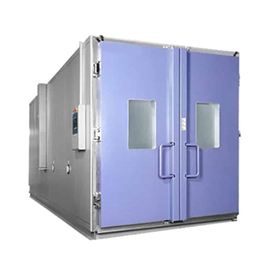
Walk-in temperature test chambers are essential tools in various industries to evaluate the effects of temperature on products and materials. These chambers enable manufacturers and researchers to control and manipulate temperature conditions, simulating real-world scenarios to assess product performance and reliability. In this article, we will explore the key design considerations for walk-in temperature test chambers.
Chamber Size and Accessibility:
The size of a walk-in temperature test chamber is an important design consideration. It should be adequately sized to accommodate the products or materials being tested. Larger chambers allow for the testing of bigger items or batches, enhancing the chamber’s versatility. Additionally, the chamber’s accessibility is crucial to facilitate the loading and unloading of test specimens. The design should include convenient access points and ample space for easy maneuverability.
Temperature Range and Uniformity:
A walk-in temperature test chamber should provide a wide range of temperature control to accommodate various testing requirements. The design should consider the capability to achieve both high and low temperature extremes, covering the desired range for the specific application. In addition to range, temperature uniformity within the chamber is crucial. The design should ensure that the temperature is evenly distributed throughout the chamber, minimizing temperature variations that can impact test results.
Humidity Control:
Many testing applications require precise humidity control in addition to temperature control. The design of a walk-in temperature test chamber should incorporate effective humidity control mechanisms, such as humidifiers and dehumidifiers, to create and maintain specific humidity levels. The ability to accurately control humidity ensures that test conditions accurately replicate real-world environments, where temperature and humidity often interact.
Insulation and Energy Efficiency:
An effectively insulated walk-in temperature test chamber minimizes heat transfer to the external environment, helping maintain stable and consistent temperature conditions. The design should include high-quality insulation materials to prevent unwanted heat exchange and minimize energy consumption. Energy efficiency should be a key consideration, as it reduces operating costs and environmental impact without compromising test performance.
Safety Features:
The design of walk-in temperature test chambers must prioritize safety. The chambers should include built-in safety features such as temperature and humidity safeguards, emergency stop buttons, and alarms to alert users in case of any abnormalities or failures. Additionally, proper ventilation and efficient air circulation systems should be integrated to prevent the accumulation of harmful gases or contaminants in the chamber.
Control and Monitoring Systems:
An effective control and monitoring system is essential for precise test execution and data collection. The design should include user-friendly interfaces that allow operators to set and adjust temperature and humidity parameters easily. These systems should also provide real-time monitoring and data logging capabilities, enabling users to track and analyze test conditions and results accurately.
Maintenance and Serviceability:
Regular maintenance and service are crucial for ensuring the long-term performance and longevity of walk-in temperature test chambers. The design should incorporate accessible components and systems that allow for easy maintenance and serviceability. Removable panels, well-positioned connectors, and clear access points contribute to efficient upkeep and troubleshooting.
Conclusion:
Design considerations for walk-in temperature test chambers greatly impact their usability, accuracy, and reliability in various testing applications. The chamber size, accessibility, temperature range, uniformity, humidity control, insulation, safety features, control systems, and maintenance all play vital roles in achieving optimal performance. By carefully considering these design factors, manufacturers can develop walk-in temperature test chambers that meet the specific needs of their industry, providing accurate and consistent temperature testing conditions for a wide range of products and materials.








You must be logged in to post a comment.